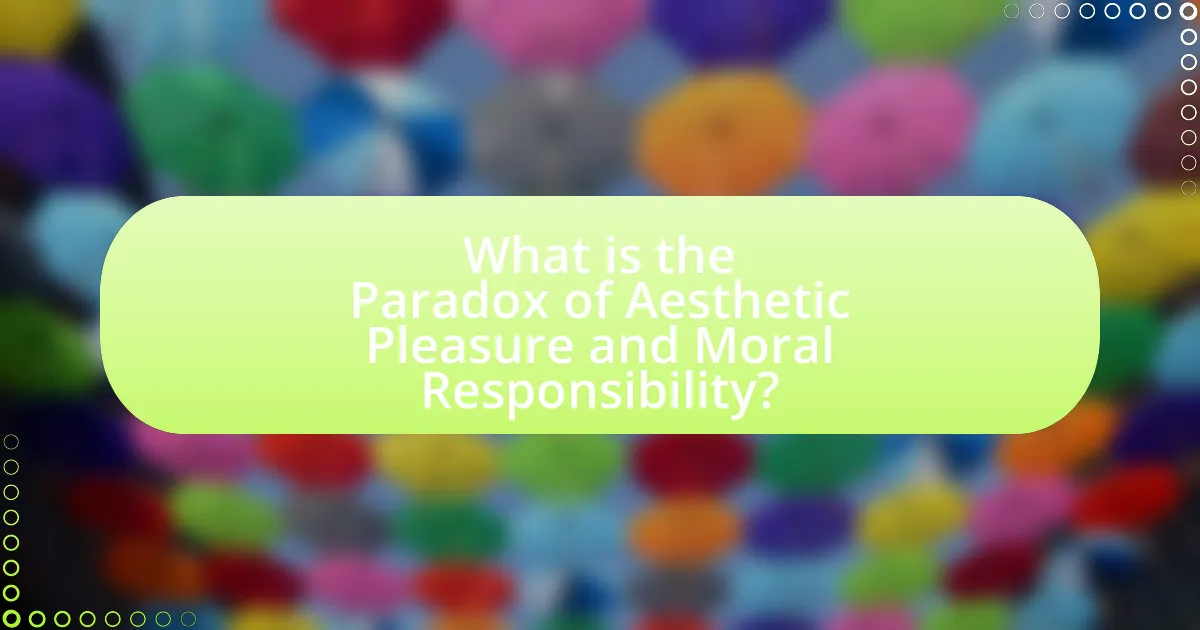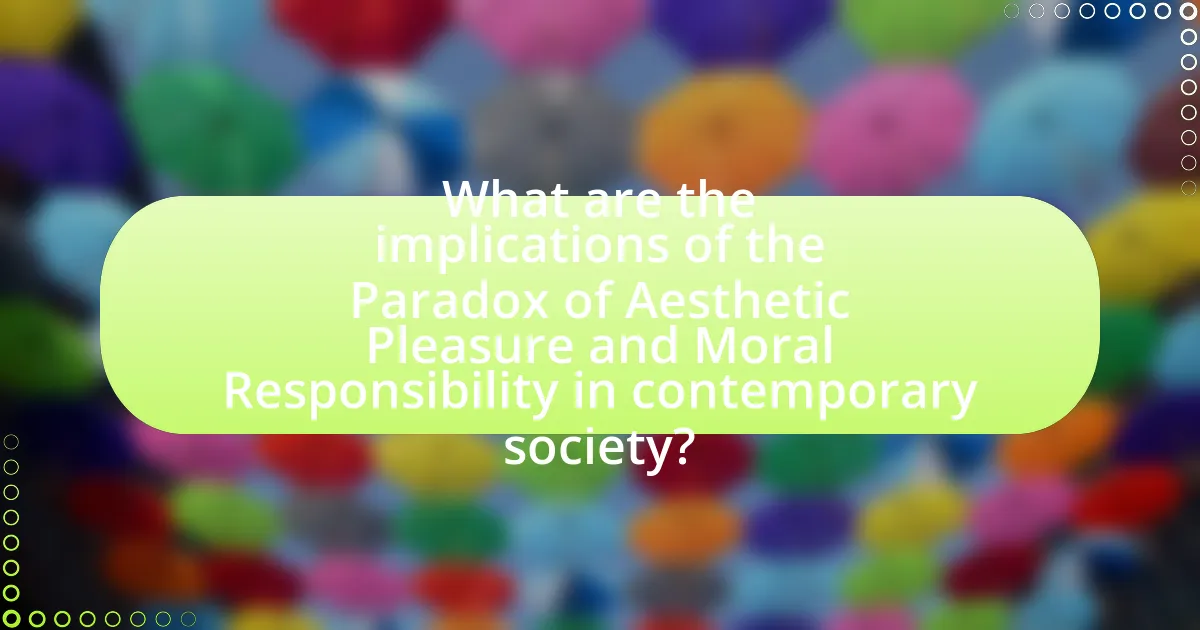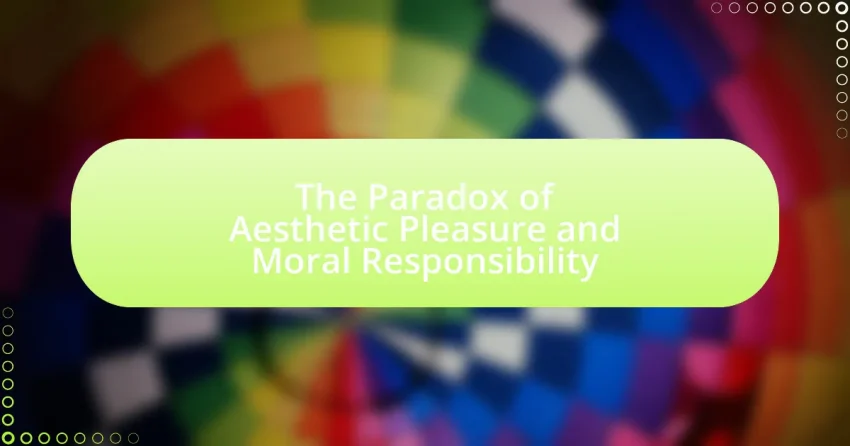The Paradox of Aesthetic Pleasure and Moral Responsibility examines the conflict between enjoying art that may embody immoral themes and the ethical implications of such enjoyment. This article explores how aesthetic experiences can evoke emotional responses that influence moral reasoning and decision-making, highlighting the interplay between aesthetic pleasure and moral accountability. It discusses various philosophical theories, cultural perceptions, and the responsibilities of both artists and consumers in navigating this paradox. Additionally, the article addresses the implications of this paradox in contemporary society, particularly in media and entertainment, and offers strategies for reconciling aesthetic enjoyment with ethical considerations.

What is the Paradox of Aesthetic Pleasure and Moral Responsibility?
The Paradox of Aesthetic Pleasure and Moral Responsibility refers to the conflict between enjoying art or beauty that may embody immoral themes and the ethical implications of such enjoyment. This paradox arises when individuals derive pleasure from artistic works that depict violence, suffering, or unethical behavior, leading to a moral dilemma about whether appreciating these works condones or endorses the actions they portray. Philosophers like Kant and Tolstoy have explored this tension, suggesting that aesthetic appreciation can exist independently of moral judgment, yet it raises questions about the responsibilities of both creators and consumers of art in relation to the moral messages conveyed.
How do aesthetic pleasure and moral responsibility interact?
Aesthetic pleasure and moral responsibility interact by influencing individuals’ perceptions and actions regarding ethical considerations. Aesthetic experiences can evoke emotional responses that may lead to a heightened awareness of moral issues, prompting individuals to reflect on their responsibilities. For instance, engaging with art that portrays social injustices can inspire empathy and motivate action towards rectifying those injustices. Research indicates that exposure to aesthetically pleasing representations of moral dilemmas can enhance moral reasoning and decision-making, as seen in studies by Haidt and Joseph (2004) in “Intuitive Ethics: How Innate Moral Intuitions Influence Our Responses to Moral Dilemmas.” This demonstrates that the interplay between aesthetic enjoyment and moral accountability can shape ethical behavior and societal norms.
What philosophical theories address this paradox?
Philosophical theories that address the paradox of aesthetic pleasure and moral responsibility include utilitarianism, Kantian ethics, and virtue ethics. Utilitarianism, proposed by philosophers like Jeremy Bentham and John Stuart Mill, suggests that actions are morally right if they promote the greatest happiness for the greatest number, which can create tension between aesthetic enjoyment and moral implications. Kantian ethics, articulated by Immanuel Kant, emphasizes duty and the moral law, arguing that aesthetic pleasure should not override moral responsibilities. Virtue ethics, rooted in Aristotle’s philosophy, focuses on character and the cultivation of virtues, suggesting that true aesthetic appreciation aligns with moral integrity. These theories provide frameworks for understanding the complex relationship between aesthetic experiences and moral obligations.
How do different cultures perceive this relationship?
Different cultures perceive the relationship between aesthetic pleasure and moral responsibility in varied ways, often influenced by their historical, philosophical, and religious contexts. For instance, Western cultures, particularly those influenced by Enlightenment thought, tend to emphasize individualism and the pursuit of personal pleasure, sometimes at the expense of moral considerations. In contrast, many Eastern cultures, such as those influenced by Confucianism, prioritize communal values and ethical responsibilities, often viewing aesthetic enjoyment as secondary to moral duty. This divergence is evident in art and literature, where Western works may celebrate hedonism, while Eastern traditions often integrate moral lessons into aesthetic expressions. Historical texts, such as Aristotle’s “Nicomachean Ethics,” illustrate the Western focus on personal virtue, while Confucian texts emphasize the importance of societal harmony and ethical behavior, showcasing the cultural differences in perceiving this relationship.
Why is understanding this paradox important?
Understanding the paradox of aesthetic pleasure and moral responsibility is important because it highlights the complex relationship between enjoyment of art and ethical considerations. This paradox challenges individuals to reflect on how their appreciation for beauty may conflict with moral implications, prompting deeper discussions about the role of art in society. For instance, engaging with art that depicts suffering can lead to moral dilemmas regarding the consumption of such works, as seen in debates surrounding controversial artists or artworks. Recognizing this paradox encourages critical thinking about personal values and societal norms, ultimately fostering a more nuanced understanding of the impact of art on moral judgment.
What implications does it have for ethical decision-making?
The paradox of aesthetic pleasure and moral responsibility implies that individuals may experience enjoyment from art or beauty that conflicts with ethical considerations, leading to complex decision-making scenarios. This tension can result in cognitive dissonance, where the appreciation of aesthetic value clashes with moral obligations, influencing choices in ways that may prioritize pleasure over ethical standards. For instance, research indicates that exposure to morally ambiguous art can alter perceptions of ethical behavior, suggesting that aesthetic experiences can shape moral judgments and decision-making processes.
How does it influence artistic expression and critique?
The paradox of aesthetic pleasure and moral responsibility influences artistic expression and critique by challenging artists to navigate the tension between beauty and ethical implications. This dynamic compels artists to consider the societal impact of their work, often leading to a deeper exploration of themes such as justice, identity, and morality. For instance, the works of artists like Ai Weiwei exemplify this influence, as his art critiques political oppression while simultaneously engaging audiences through aesthetic appeal. This intersection of aesthetics and ethics prompts critics to evaluate not only the artistic merit but also the moral messages conveyed, thereby enriching the discourse surrounding art and its role in society.

What are the key components of the Paradox of Aesthetic Pleasure and Moral Responsibility?
The key components of the Paradox of Aesthetic Pleasure and Moral Responsibility include the conflict between enjoying art that depicts immoral actions and the ethical implications of such enjoyment. This paradox arises when individuals derive pleasure from aesthetic experiences that may glorify or trivialize moral transgressions, leading to a tension between personal enjoyment and societal moral standards. For instance, literature or films that portray violence or unethical behavior can elicit strong emotional responses, yet this enjoyment raises questions about the viewer’s moral stance and responsibility towards the content. The philosophical discourse surrounding this paradox often examines how aesthetic appreciation can coexist with moral judgment, highlighting the complexities of human experience in reconciling pleasure with ethical considerations.
What role does aesthetic pleasure play in moral judgments?
Aesthetic pleasure significantly influences moral judgments by shaping emotional responses and perceptions of ethical situations. Research indicates that individuals often derive moral evaluations from their aesthetic experiences, as beauty can evoke positive emotions that enhance moral consideration. For instance, studies show that aesthetically pleasing environments can lead to more altruistic behavior, suggesting that aesthetic enjoyment can foster empathy and moral engagement. This connection highlights how aesthetic pleasure not only enriches personal experiences but also plays a crucial role in guiding moral reasoning and decision-making.
How can pleasure derived from art conflict with moral values?
Pleasure derived from art can conflict with moral values when the content of the art promotes harmful ideologies or behaviors. For instance, artworks that glorify violence, racism, or misogyny may provide aesthetic enjoyment but simultaneously undermine ethical principles by normalizing or trivializing serious social issues. Historical examples include the controversial reception of works like “The Birth of a Nation,” which, while artistically significant, perpetuated racist stereotypes and incited violence against African Americans. This illustrates how the enjoyment of art can lead to moral dilemmas, as individuals may struggle to reconcile their appreciation for the artistic qualities with the negative societal implications of the themes presented.
What examples illustrate this conflict in literature and visual arts?
Examples illustrating the conflict between aesthetic pleasure and moral responsibility in literature include Fyodor Dostoevsky’s “Crime and Punishment,” where Raskolnikov grapples with the moral implications of his actions despite the intellectual justification he initially feels. In visual arts, Pablo Picasso’s “Guernica” serves as a powerful commentary on the horrors of war, evoking emotional responses while simultaneously confronting viewers with the moral atrocities depicted. These works exemplify how both literature and visual arts can provoke aesthetic enjoyment while challenging ethical considerations, highlighting the tension between beauty and moral accountability.
How does moral responsibility shape our appreciation of art?
Moral responsibility significantly influences our appreciation of art by prompting us to consider the ethical implications of the artist’s actions and the content of the artwork. When individuals recognize that an artist has engaged in morally questionable behavior, such as committing crimes or promoting harmful ideologies, it can lead to a diminished appreciation for their work. For instance, the backlash against artists like Michael Jackson and Roman Polanski illustrates how allegations of misconduct can overshadow their artistic contributions, causing audiences to grapple with the conflict between aesthetic enjoyment and moral judgment. This dynamic highlights that our engagement with art is not solely based on aesthetic criteria but is also deeply intertwined with our values and ethical considerations.
What responsibilities do artists have towards their audience?
Artists have a responsibility to engage their audience thoughtfully and ethically. This includes creating work that respects cultural sensitivities, promotes inclusivity, and encourages critical thinking. For instance, artists often influence societal norms and values through their work, as seen in movements like the Harlem Renaissance, which highlighted racial issues and fostered dialogue. Additionally, artists should be aware of the potential impact of their content, as evidenced by studies showing that media representation can shape public perception and attitudes. Therefore, artists must consider the implications of their creations on their audience’s beliefs and behaviors.
How can consumers of art navigate moral dilemmas?
Consumers of art can navigate moral dilemmas by critically assessing the ethical implications of the artwork and its creator. This involves evaluating the context in which the art was produced, including the artist’s background, intentions, and any controversies surrounding their work. For instance, consumers can consider the impact of the artwork on society and whether it perpetuates harmful ideologies or behaviors. Engaging in discussions about the moral responsibilities of artists and the potential consequences of their work can also aid in this navigation. Research indicates that consumers who actively reflect on these factors are more likely to make informed decisions regarding their engagement with art, balancing aesthetic enjoyment with ethical considerations.

What are the implications of the Paradox of Aesthetic Pleasure and Moral Responsibility in contemporary society?
The implications of the Paradox of Aesthetic Pleasure and Moral Responsibility in contemporary society highlight the tension between enjoying art and media that may promote unethical themes while grappling with the moral responsibility to reject such content. This paradox manifests in debates over whether individuals can appreciate artistic works that depict violence, racism, or other moral failings without endorsing those values. For instance, the popularity of films or literature that explore dark themes raises questions about the audience’s complicity in perpetuating harmful ideologies. Research indicates that exposure to certain narratives can influence societal attitudes and behaviors, suggesting that aesthetic enjoyment may inadvertently normalize or desensitize audiences to moral issues. Thus, individuals and society must navigate the complexities of aesthetic appreciation while maintaining ethical standards, leading to ongoing discussions about censorship, artistic freedom, and moral accountability.
How does this paradox manifest in modern media and entertainment?
The paradox of aesthetic pleasure and moral responsibility manifests in modern media and entertainment through the tension between enjoyment of content and the ethical implications of its themes. For instance, popular films and television shows often depict violence, exploitation, or controversial social issues that captivate audiences while simultaneously raising questions about the moral responsibility of creators and consumers. A notable example is the success of series like “Game of Thrones,” which, despite its critical acclaim and viewer engagement, faced backlash for its portrayal of violence and misogyny, prompting discussions about the impact of such narratives on societal values. This duality illustrates how audiences can derive pleasure from artistic expression while grappling with the moral consequences of the content they consume.
What are the ethical considerations in film and television?
Ethical considerations in film and television include issues of representation, consent, and the impact of content on audiences. Representation involves ensuring diverse and accurate portrayals of different cultures, genders, and identities to avoid perpetuating stereotypes. Consent is crucial, particularly regarding the depiction of sensitive subjects or the involvement of real individuals in documentary formats. The impact of content on audiences raises concerns about the potential for glorifying violence, promoting harmful behaviors, or influencing societal norms. Research indicates that media can shape perceptions and attitudes, highlighting the responsibility creators have in considering the societal implications of their work.
How do social media platforms influence perceptions of this paradox?
Social media platforms significantly influence perceptions of the paradox of aesthetic pleasure and moral responsibility by amplifying visual content that often prioritizes aesthetic appeal over ethical considerations. This amplification leads users to engage more with visually pleasing content, which can overshadow moral implications associated with that content. For instance, studies show that platforms like Instagram and TikTok promote images and videos that garner likes and shares, often neglecting the ethical context behind the visuals, such as issues related to exploitation or environmental impact. Consequently, users may develop a skewed understanding of morality, where aesthetic enjoyment takes precedence over critical ethical evaluation, thereby reinforcing the paradox.
What strategies can individuals use to reconcile aesthetic pleasure with moral responsibility?
Individuals can reconcile aesthetic pleasure with moral responsibility by adopting strategies such as critical consumption, ethical engagement, and mindful appreciation. Critical consumption involves evaluating the origins and impacts of art and products, ensuring they align with personal values. Ethical engagement encourages individuals to support artists and creators who prioritize social justice and sustainability, thereby enhancing the moral dimension of aesthetic enjoyment. Mindful appreciation fosters awareness of the broader implications of beauty, prompting individuals to reflect on how their enjoyment of aesthetics can contribute positively to society. These strategies are supported by research indicating that conscious choices in consumption can lead to greater satisfaction and alignment with personal ethics, as seen in studies on consumer behavior and ethical consumption patterns.
How can one critically engage with art while maintaining ethical standards?
One can critically engage with art while maintaining ethical standards by applying a framework that emphasizes respect for the artist’s intent, cultural context, and the impact of the artwork on society. This approach involves analyzing the themes and messages within the art while being mindful of the potential for misinterpretation or harm. For instance, when examining works that address sensitive social issues, it is crucial to consider the perspectives of marginalized communities represented in the art, ensuring that their voices are acknowledged and respected. Ethical engagement also requires transparency in discussing the artist’s background and the historical context of the artwork, which can illuminate biases and power dynamics at play. By fostering an inclusive dialogue that values diverse interpretations and critiques, one can appreciate the aesthetic qualities of art without compromising moral responsibility.
What practices promote a balanced appreciation of art and morality?
Practices that promote a balanced appreciation of art and morality include critical engagement with artworks, interdisciplinary dialogue, and ethical reflection. Critical engagement involves analyzing the context, intent, and impact of art, which fosters an understanding of its moral implications. Interdisciplinary dialogue encourages collaboration between artists, ethicists, and philosophers, facilitating a broader perspective on the relationship between aesthetic experiences and moral values. Ethical reflection involves considering the societal and cultural consequences of art, prompting individuals to evaluate their own moral responsibilities in relation to artistic expression. These practices collectively enhance the ability to appreciate art while maintaining a moral framework, as evidenced by studies that show increased awareness of ethical issues in art leads to more responsible consumption and creation of artistic works.
